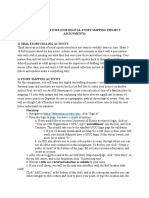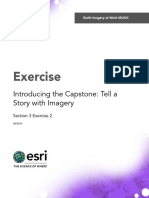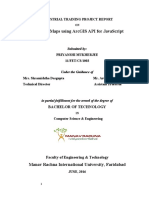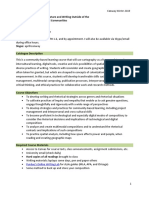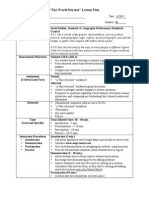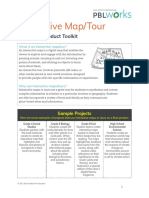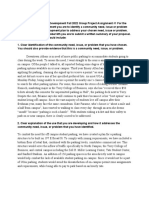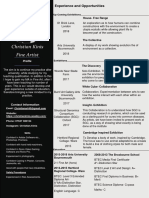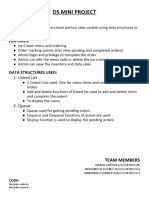STORY MAPPING ASSIGNMENT
For this assignment, you will learn how to use visual and text media to create a narrative for your story. First,
we will use ArcGIS Story maps to create a tour of a familiar place by mapping 7 sites with images and text
explaining why these sites are significant locations of social justice practices Organize the site as a geographic
path of chronological events. Next, we will use Knight Lab’s Timeline tool to create a timeline of events at
these sites to help the user better understand our narrative.
Story maps
1. Navigate to https://storymaps.arcgis.com/, click “Sign In”
2. From the Sign-In page, you have a couple of options:
a. If you would like to use your University of Illinois account to login, click on
“Your ArcGIS Organization’s URL”, type “univofillinois” into the box, and click
Continue. This should take you to the standard UIUC login page for validation.
i. If you’ve already downloaded ArcMap for a GIS class or done other GIS
work, you should definitely have a UIUC login. If this doesn’t work, just
move on to option “b”.
b. ArcGIS also allows you to create a free public account, through where you can
use all of the tools mentioned in this assignment. To do this, just click “Create a
public account” at the bottom of the page, fill out your relevant information, and
create an account.
3. After you are logged in and at the ArcGIS Story Maps homepage, click “New Story” in
the top left corner, and in the dropdown click “Guided map tour”.
4. Provide a title and a brief introduction or subtitle to your story.
5. If you scroll down, you will see the map tour interface, with the first location slide ready.
Click “Add Location” at the bottom of this slide, and in the subsequent window you can
either navigate to the location and click to place your point, or type the location into the
search bar in the top left. After placement, you can also click and drag the point to adjust
its location. When finished, click “Add location” in the bottom left.
6. Provide a title, image, and description for this location (the image can be whatever you
want – the outside of the building, a personal event in the building, etc; just make it
relevant to the location or your description).
7. Click the plus sign button at the right of the slide bar, and create your remaining
locations.
8. You can play around with a variety of settings to personalize the story map. Clicking
“Design” at the top of the screen will allow you to choose different visual themes for
your Story map. The “Map Options” button on the top right of the map will allow you to
change the base map (for example, using satellite imagery) and the point colors. If you
scroll up or down from the map, you should see plus sign buttons that will allow you to
add additional elements to this site, like more text, images or video. Feel free to use these
�as you like (for example, including an outro or conclusion message after the map).
9. At the very bottom of the web page is a credits portion. If, for example, you used Google
Maps Street View for your location images, go ahead and credit that here.
10. When you are happy with your story map, click on “Preview” at the top of the page to see
how viewers will experience the map. From this page, click “Edit story” to go back to the
map creation page.
11. When you are ready to share, click “Publish”, and select “Everyone” when prompted to
tell who can see your story. If you logged in through UIUC’s domain, you should also
have a “Only within my organization” option, you can select this as well.
a. After you select “Everyone”, the page isn’t automatically put on ArcGIS’s main
page for everyone to look at, but anyone with the link to the page can open this.
This is one good reason not to include any sensitive information.
12. After clicking publish, you should see a link icon at the top of your screen. Click this, and
the page url is automatically added to your computer’s clipboard. To submit, simply paste
this into the assignment’s submission area.
Resources to get familiar:
1. A step-by-step written tutorial of Getting started with Story
Maps: https://storymaps.arcgis.com/stories/cea22a609a1d4cccb8d54c650b595bc4
2. A step-by-step video tutorial of Getting started with Story Maps: https://www.youtube.com/watch?
v=qdn05wkgYw0&t=934s
3. A curated selection of stories created using classic Esri Story Maps: https://storymaps-
classic.arcgis.com/en/gallery/#s=0
4. Classic Story Map styles: https://storymaps-classic.arcgis.com/en/
5. Spring 2021 Student Final Project Exemplars:
The Story of Kyle Rittenhouse
https://storymaps.arcgis.com/stories/b728d4749775411fbd02f39bdd8d60de
Ahmaud Arbery
https://storymaps.arcgis.com/stories/012293d871d5483c9c8c77159dc44050
George Floyd's Story
https://storymaps.arcgis.com/stories/19ddcfd47e014fbcbb8def7bea58fea8
Remembrance Project Map
https://storymaps.arcgis.com/stories/4e5f08cb1df841ea9ef7aeb5bbccf523
� Race, Funding and neighborhoods
https://storymaps.arcgis.com/stories/ccdd51d130894e3e9dd28ec607032505
GETTING STARTED WITH ARCGIS STORYMAP GUIDE
Logging into ArcGIS StoryMaps
Navigate to: https://storymaps.arcgis.com/
Use your University of Illinois account to login, click on
“Your ArcGIS Organization’s URL”, type “univofillinois” into the box, and click Continue.
This should take you to the standard UIUC login page for validation.
Type your netid and password
After you are logged in and at the ArcGIS Story Maps homepage, click “New Story” and follow the demo below
DEMO STORY TEXT:
[Title]
7 places to see in the Champaign-Urbana metropolitan region
[Subtitle]
Exploring Urbana Champaign
[Byline]
By [Your name] | Oct 24,2021
[Insert Heading]
INTRODUCTION
[Insert Paragraph]
The Champaign–Urbana metropolitan area, also known as Champaign–Urbana as well as Chambana is
a metropolitan area in east-central Illinois. With a diverse community and expanding population, the
Champaign-Urbana metropolitan area stands out from its agricultural surroundings in central Illinois. Roughly
130 miles from both Chicago and Indianapolis, this sprawling community is defined much in part by the
campus of the University of Illinois, home of the Fighting Illini.
Along with the academic pursuits and historic architecture found on campus, the university adds to the city
with an array of public attractions and things to do. A few of the community additions sponsored by the
university include art and cultural museums, a stunning arboretum, and spirited sporting events throughout
the year.
�[Express Map]
Search for:
1. University of Illinois Urbana Champaign
2. Crystal Lake Park
3. Downtown Champaign
4. Spurlock museum
5. Meadowbrook Park
6. UI Arboretum
7. Japan house
[Instructions]
i. Mark them as points on the Express map
ii. Add image, name, and brief description
iii. Add text annotations if you want
[Insert Heading]
1. UNIVERSITY OF ILLINOIS URBANA CHAMPAIGN
[Insert Subheading]
A public land-grant research university located in the twin cities of Champaign and Urbana.
[Insert Paragraph]
Founded in 1867, the University of Champaign-Urbana has helped define the city for over 150 years. The
institution currently educates more than 40,000 students each semester. The top-tier degrees and programs
offered at this Big 10 public university attract a large enrollment, and the sprawling campus and academic
spirit make many proud to be Fighting Illini alum.
A part of the larger University of Illinois System, including campuses in Springfield and Chicago, the
Champaign-Urbana campus is well integrated into the city. Alongside cultural attraction and entertainment, a
youthful energy stems from campus and throughout the streets of Champaign-Urbana.
Museum offer displays of cultural works on campus with free admission.
[Insert Heading]
2. CRYSTAL LAKE PARK
[Insert Subheading]
A scenic urban forest with a parkway drive and numerous amenities.
[Insert Paragraph]
On the north side of the city, Crystal Lake Park is a crown jewel of the Urbana Park District. With dense urban
forest and scenic surroundings, the park also provides many community attractions. On the north end of the
park, a Family Aquatic Center features an overhanging rock wall, a zero-depth entry pool, and three different
waterslides. The Anita Purves Nature Center is also on the north side of the park and features educational
resources, including classes and animal encounters. The Nature Center also features an interpretive trail
through the adjacent Busey Woods natural area. More fun is found in the south region of Crystal Lake Park.
Crystal Lake, itself, is on the south side of the park, including the adjacent Lake House large-group rental
�facility. All visitors to the park can enjoy the water, and non-motorized boat rentals are available between May
and September.
Other popular attractions on the south side of the park include playgrounds, picnic areas, and a unique
landscaped brick labyrinth that is a challenge to work your way through. Interpretive information about the
surrounding landscapes is scattered throughout the entire park.
[Insert Heading]
3. DOWNTOWN CHAMPAIGN
[Insert Subheading]
A lively entertainment district that has quickly emerged as a favorite destination shoppers and diners.
[Insert Paragraph]
Just a few miles northwest of Campustown and the university, downtown Champaign is lined with local shops
and restaurants. Breakfast is a popular option at the locally owned Sam's Cafe, and places like Bacaro feature
seasonal menus and unique American cuisine. Al fresco dining is abundant in downtown during the summer
months.
Younger explorers of the city can find plenty of hands-on entertainment at the Orpheum Children's
Museum downtown, located in a historic and renovated vaudeville theater. For bibliophiles and casual
readers, Jane Addams Bookshop is a locally owned favorite. The Aroma Café is regarded as one of the best
coffee shops downtown, though Caffe Benne is also a contender.
Among the many events and concerts that take place downtown throughout the year, the two separate
Fridays of Street Fest in the summer is where you'll find the best lineup of live music and dancing in the street.
[Insert Heading]
4. SPURLOCK MUSEUM
[Insert Subheading]
An ethnographic museum at the University of Illinois at Urbana-Champaign.
[Insert Paragraph]
On the east side of the U of I campus, this Museum of World Cultures contains more than 50,000 artifacts
from across the globe. Connected by a "Central Core of Humanity", the nine galleries and rotating exhibits at
the Spurlock Museum highlight human beings throughout history from different regions of the world.
Ancient Mesopotamia, East Asia, and North America are represented among many other cultures in the
museum. Each gallery contains eye-catching displays and artifacts including marble sculptures, traditional
headwear, and ancient tools. With 55,000 square feet and two floors of displays to discover, an entire day can
be devoted to this esteemed cultural museum.
Admission to the museum is free for all community members and visitors, though a suggested donation of $3
goes to help museum services. The museum is open throughout the year and closed on Mondays.
[Insert Heading]
� 5. MEADOWBROOK PARK
[Insert Subheading]
Extensive natural area that includes acres of restored prairie, several gardens & trails.
[Insert Paragraph]
For those that enjoy the outdoors, Meadowbrook Park is a popular place to walk in nature. More than five
miles of paved and unpaved trails weave throughout the park. Other popular outlets for enjoyment include a
sculpture garden, a historic farmstead, and a 13,000-square-foot playground – the largest in the Urbana Park
District.
The numerous gardens and natural spaces of Meadowbrook Park also attract a lot of interest. The Park
features a unique sensory garden, an 80-acre tallgrass prairie, and an organic community garden where
residents can reserve a plot.
[Insert Heading]
6. UI ARBORETUM
[Insert Subheading]
A beautiful botanical garden with seasonal flora species
[Insert Paragraph]
Encompassing 160 acres of the university's south campus, the UI Arboretum is a bountiful collection of
gardens, habitats, and special features. As an outdoor classroom for students studying plant sciences or
landscape design, this sprawling public space is also well used as an easy escape into nature.
Different gardens like the Sen Cherry Tree Allée are fun to visit during the spring bloom, and the Idea Garden
is known to provide some inspiration throughout the year. Cultural attractions are also within this tree-lined
space, including the university's Japan House complete with a Zen and rock garden.
The arboretum is open throughout the year between sunrise and sunset. Admission is free, though visitors
should expect to pay for parking if they want to park nearby.
[Insert Heading]
7. JAPAN HOUSE
[Insert Subheading]
A Japanese cultural center amidst Zen gardens and a lake
[Insert Paragraph]
Within the University of Illinois Arboretum, this traditional Japanese-style home aims to broaden perspectives
and provide a moment of tranquility in the day. As part of the College of Fine and Applied Arts, the Japan
House offers experiential education through various programs and events, as well as aesthetic pleasure with
features like the Japanese tea garden outside.
�Students and the public are encouraged to check out the house and grounds from dawn to dusk throughout
the spring, summer, and fall. The house offers a wide variety of educational opportunities and cultural
demonstrations throughout the year. A few of the program include traditional tea ceremonies, Zen studies,
and annual Gallery Days.
Explore the basic, media and
immersive sections using the same
text above, shorten the paragraphs
if you like:
Explore the various methods to
represent the same text above in
the following ways:
[Basic]
[Slideshow]
[Sidecar]
[Map tour]
Write a short script for your own individual topic and analyze which method of representation suits it best.

